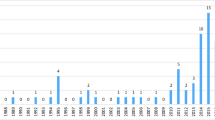Conclusion
This note suggests that the persuit of budget maximization by public bureaus is partially dependent on the size of the jurisdiction in which the bureau is located. The larger is the jurisdiction, the greater is the degree of rational ignorance and the more significant are moving costs, each of which contribute to bureau monopoly power. The additional monopoly power in larger jurisdictions provides the incentive for, and enables, the bureau personnel to exert greater pressure on politicians to expand bureau budgets and benefits to personnel. Our examination of police services showed these hypotheses to be consistent with the evidence. In particular, the size of budgets grew far more rapidly than did population, and the proportion of public employees proved to be a significant variable where personnel expenditures were considered.
Similar content being viewed by others
References
Bellante, D., and Long, J. (1982). The political economy of the rent-seeking society: The case of public employees and their unions. Journal of Labor Research 2: 1 - 14.
Bush, W., and Denzau, A. (1977). The voting behavior of bureaucrats and public sector growth. In T. Borcherding (Ed.), Budgets and bureaucrats: The sources of government growth. Durham: Duke University Press.
DiLorenzo, T. (1981). An empirical assessment of the factor supplier pressure group hypothesis. Public Choice 37: 559 - 568, 301.105, p. 976.
Gabler, L. (1969). Economies and diseconomies of scale in urban public sectors. Land Economics 45: 425 - 434.
Garmire, B. (1972). The police role in an urban society. In R. Steadman (Ed.), The police and the community. Baltimore: The John Hopkins Press.
Niskanen, W. (1971). Bureaucracy and representative government. Chicago: Aldine.
Ostrom, E. (1976). Size and performance in a federal system. Publius 6: 33 - 73.
Parks, R. (1979). Police reorganisation: A review of its evaluation. Review of Criminal Justice Evaluation, June: 237 – 256.
Quinn, J. (1979). Wage differences among older workers in the public and private sectors. Journal of Human Resources 14: 41 - 62.
Smith, S. (1976). Pay differentials between federal government and private sector workers. Industrial and Labor Relations Review 29: 179 - 197.
Spann, R.P.M. (1977). Public versus private provision of governmental services. In T. Borcherding (Ed.), Budgets and bureaucrats: The source of government growth. Durham: Duke University Press.
Stigler, G. (1972). Economic competition and political competition. Public Choice 13: 19 - 106.
Tullock, G. (1965). The politics of bureaucracy. Washington D.C.: Public Affairs Press.
Tullock, G. (1967). Towards a mathematics of politics. Ann Arbor: University of Michigan Press.
Tullock, G. (1974). Dynamic hypothesis on bureaucracy. Public Choice, Spring: 127 – 131.
Tullock, G. (1977). What is to be done? In T. Borcherding (Ed.), Budgets and bureaucrats: The sources of government growth. Durham: Duke University Press.
Author information
Authors and Affiliations
Additional information
This research was commenced while I was a graduate student at Virginia Polytechnic Institute and State University. I wish to thank Gordon Tullock for his comments and assistance.
Rights and permissions
About this article
Cite this article
Nellor, D.C.L. Public bureau budgets and jurisdiction size: An empirical note. Public Choice 42, 175–183 (1984). https://doi.org/10.1007/BF00124159
Issue Date:
DOI: https://doi.org/10.1007/BF00124159




